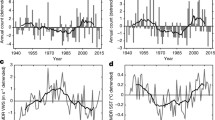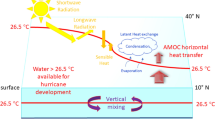Abstract
Climatic conditions that affect the interannual variability of Caribbean hurricanes are studied. Composite meteorological and oceanographic reanalysis fields are constructed for active and inactive seasons since 1979, and differences are calculated for spring and summer periods to provide guidance in statistical analysis. Predictors are extracted for areas exhibiting high contrast between active and inactive seasons, and intercomparisons are made. Zonal winds north of Venezuela exhibit westerly anomalies prior to active years, so coastal upwelling and the north Brazil current are diminished. Rainfall increases in the Orinoco River basin, creating a fresh warm plume north of Trinidad. The predictor time series are regressed onto an index of Caribbean hurricanes, and multivariate algorithms are formulated. It is found that atmospheric kinematic and convective predictors explain only ∼20% of hurricane variance at 3–5-month lead time. Subsurface ocean predictors offer higher levels of explained hurricane variance (42%) at 3–5-month lead time, using 1–200-m-depth-averaged temperatures in the east Pacific and southern Caribbean. We place the statistical results in a conceptual framework to better understand climatic processes anticipating Caribbean hurricanes.








Similar content being viewed by others
References
Ballenzweig EM (1959) Relation of long-period circulation anomalies to tropical storm formation and motion. J Meteorol 16:121–139
Basher RE, Zheng X (1995) Tropical cyclones in the Southwest Pacific: spatial patterns and relationships to the Southern Oscillation and sea surface temperature. J Climate 8:1249–1260
Carlson TN (1971) An apparent relationship between the sea-surface temperature of the tropical Atlantic and the development of African disturbances into tropical storms. Mon Weather Rev 99:309–310
Carton JA, Giese BS (2008) A reanalysis of ocean climate using Simple Ocean Data Assimilation (SODA). Mon Weather Rev 136:2999–3017
Chan JC (1995) Tropical cyclone activity in the NW Pacific in relation to the stratospheric quasi-biennial oscillation. Mon Weather Rev 123:2567–2571
Delworth TL, Mann ME (2000) Observed and simulated multidecadal variability in the Northern Hemisphere. Clim Dyn 16:661–676
Elsner JB, Murnane RJ, Jagger TH (2006) Forecasting U.S. hurricanes 6 months in advance, Geophys Res Lett 33:doi:10.1029/2006GL025693
Ffield A (2007) Amazon and Orinoco river plumes and NBC rings: bystanders or participants in hurricane events? J Climate 20:316–333
Franklin JL, Feuer SE, Kaplan J, Aberson SD (1996) Tropical cyclone motion and surrounding flow relationships: beta gyres. Mon Weather Rev 124:64–84
Goddard L, Mason SJ, Zebiak SE, Ropelewski CF, Basher R, Cane MA (2001) Current approaches to seasonal-to-interannual climate predictions. Int J Climatol 21:1111–1152
Goldenberg SB, Shapiro LJ (1996) Physical mechanisms for the association of El Niño and West African rainfall with Atlantic major hurricane activity. J Climate 9:1169–1187
Goldenberg SB, Landsea CW, Mestas-Nuñez AM, Gray WM (2001) The recent increase in Atlantic hurricane activity: causes and implications. Science 293:474–479
Gray WM (1968) Global view of the origin of tropical disturbances and storms. Mon Weather Rev 96:669–700
Gray WM (1984a) Atlantic seasonal hurricane frequency: Part I: El Niño and 30 mb quasi-biennial oscillation influences. Mon Weather Rev 112:1649–1668
Gray WM (1984b) Atlantic seasonal hurricane frequency: Part II: forecasting its variability. Mon Weather Rev 112:1669–1683
Gray WM (1990) Strong association between West African Rainfall and U.S. landfall of intense hurricanes. Science 249:1251–1256
Gray WM, Landsea CW, Mielke PW Jr, Berry KJ (1992a) Predicting Atlantic seasonal hurricane activity 6–11 months in advance. Weather Forecast 7:440–445
Gray WM, Sheaffer JD, Knaff JA (1992b) Influence of the stratospheric QBO on ENSO variability. J Meteor Soc Jpn 70:975–995
Gray WM, Landsea CW, Mielke PW, Berry KJ (1993) Predicting Atlantic basin seasonal tropical cyclone activity by 1 August. Weather Forecast 8:73–86
Gray WM, Landsea CW, Mielke PW Jr, Berry KJ (1994) Predicting Atlantic basin seasonal tropical cyclone activity by 1 June. Weather Forecast 9:103–115
Gray WM, Sheaffer JD, Landsea CW (1997) Climate trends associated with multi-decadal variability of intense Atlantic hurricane activity. In: Diaz, Pulwarty (eds.) Hurricanes, climatic change and socioeconomic impacts: a current perspective. Springer, New York, pp. 15–53
Gu D, Philander S (1995) Secular changes of annual and interannual variability in the tropics during the past century. J Climate 8:864–876
Jury MR (1993) A preliminary study of climatological associations and characteristics of tropical cyclones in the SW Indian Ocean. Meteorol Atmos Phys 51:101–115
Jury MR, Enfield DB (2010) Environmental patterns associated with active and inactive Caribbean hurricane seasons. J Climate 23(8):2146–2160
Jury MR, Huang B (2004) The Rossby wave as a key mechanism of Indian Ocean climate variability. Deep Sea Res 51:2123–2136
Jury MR, Pathack B, Parker B (1999) Climatic determinants and statistical prediction of tropical cyclone days in the SW Indian Ocean. J Climate 12:1738–1746
Jury MR, Winter A, Malmgren B (2007) Sub-regional precipitation climate of the Caribbean and relationships with ENSO and NAO. J Geophys Res 112: D16107. doi:10.1029/2006JD007541
Kanamitsu MK et al (2002) NCEP–DOE AMIP-II Reanalysis2. Bull Am Meteorol Soc 83:1631–1643. doi:10.1175
Klotzbach PJ (2006) Trends in global tropical cyclone activity over the past twenty years (1986–2005). Geophys Res Lett 33:L10805. doi:10.1029/2006GL025881
Klotzbach PJ, Gray WM (2006) Causes of the unusually destructive 2004 Atlantic basin hurricane season. Bull Amer Met Soc 87:1325–1333
Knaff JA (1993) Evidence of a stratospheric QBO modulation of tropical convection. Atmospheric Science Paper No. 520, Colorado State University, p. 91
Knaff JA (1997) Implications of summertime sea level pressure anomalies in the tropical Atlantic region. Mon Weather Rev 10:789–804
Landsea CW, Gray WM (1992) The strong association between western Sahel monsoon rainfall and intense Atlantic hurricanes. J Climate 5:435–453
Landsea CW, Gray WM, Mielke PW Jr, Berry KJ (1994) Seasonal forecasting of Atlantic hurricane activity. Weather 49:273–284
Mann ME, Park J (1994) Global-scale modes of surface temperature variability on interannual to century timescales. J Geophys Res 99(D12), 25,819–25,833
Nicholls N (1985) Predictability of interannual variations of Australian seasonal tropical cyclone activity. Mon Weather Rev 113:1144–1149
Saunders MA, Harris AR (1997) Statistical evidence links exceptional 1995 Atlantic hurricane season to record sea warming. Geol Res Letters 24:1255–1258
Schlesinger ME, Ramankutty N (1994) An oscillation in the global climate system of period 65–70 years. Nature 367:723–726
Shapiro LJ (1982) Hurricane climatic fluctuations. Part II: relation to large-scale circulation. Mon Weather Rev 110:1007–1013
Shapiro LJ (1987) Month-to-month variability of the Atlantic tropical circulation and its relationship to tropical storm formation. Mon Weather Rev 115:2598–2614
Shapiro LJ (1989) The relationship of the quasi-biennial oscillation to Atlantic tropical storm activity. Mon Weather Rev 117:1545–1552
Shapiro LJ, Goldenberg SB (1998) Atlantic sea surface temperatures and tropical cyclone formation. J Climate 11:578–590
Vizy EK, Cook KH (2010) Influence of the Amazon/Orinoco Plume on the summertime Atlantic climate. J Geophys Res 115:D21112. doi:10.1029/2010JD014049
Watterson IG, Evans JL, Ryan BF (1995) Seasonal and interannual variability of tropical cyclogenesis: diagnostics from large-scale fields. J Climate 8:3052–3066
Wendland WM (1977) Tropical storm frequencies related to sea surface temperatures. J Appl Meteorol 16:477–481
Acknowledgments
We thank NSF Epscor for funding this research through the Physics Department, University of Puerto Rico Mayaguez. Juan Gonzalez and Edvier Cabassa assisted the data analysis.
Author information
Authors and Affiliations
Corresponding author
Rights and permissions
About this article
Cite this article
Jury, M.R., Rodríguez, E. Caribbean hurricanes: interannual variability and prediction. Theor Appl Climatol 106, 105–115 (2011). https://doi.org/10.1007/s00704-011-0422-z
Received:
Accepted:
Published:
Issue Date:
DOI: https://doi.org/10.1007/s00704-011-0422-z




